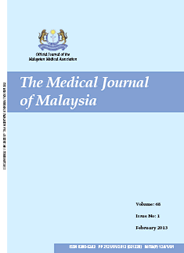MJM, Vol 70 Supplement 1 September 2015
Using occupational groups for community based NCD
Prevention
*Centre for Occupational and Environmental Health-University of Malaya (COEHUM), Department of Social and Preventive Medicine, Faculty of Medicine, University of Malaya, Kuala Lumpur, **Julius Centre University of Malaya (JCUM), Department of Social and Preventive Medicine, Faculty of Medicine, University of Malaya, Kuala Lumpur
ABSTRACT
Introduction: The prevalence of non-communicable diseases (NCD) and its risk factors in Malaysia are on the increase. From the National Health and Morbidity Survey in 1996 and 2011, the prevalence of obesity, Type 2 diabetes and hypertension have increased from 4.4% to 15.1%, 8.3% to 15.1%, and 29.9% to 32.7% respectively. The preliminary results from the Social Security Organization’s Health Screening Program for workers ≥40 year-old found similar results; i.e., obesity, 18%, diabetes, 15% and hypertension, 19%. Prevention of NCD using occupational groups has been recognised internationally as an appropriate setting for health promotion.
Methods: This paper describe the UM Wellness programme effort in NCD prevention.
Results: The UM Wellness programme was launched in June 2008 by the Deputy Minister for Higher Education, and in its first six months, more than 1,200 staff ≥35 year-old from University of Malaya (UM) were screened for common diseases, and those with abnormal results were referred to physician and gynaecologist in the University Malaya Medical Centre (UMMC). A website was set-up to disseminate the results and for health promotion. The prevalence of obesity and hypercholesterolemia was 46% and 34% respectively. Every year the UM Wellness organised a road show in UM, together with UMMC and other organisation, like LPPKN and National Kidney Foundation, to promote the programme. Over the years other health promotional programmes were incorporated into the UM Wellness programme; i.e., Employee Assistance Programme (EAP), Stress Management Workshop, Quit Smoking Clinic, Diet Wellness clinic, and weight management programme (GSlim). The programme was successful in reducing the overall total cholesterol, diastolic and systolic blood pressure of the participants.
Conclusion: A well planned community based NCD prevention with screening and health promotion programme is effective at reducing the risk for NCD. The future is to replicate the success of UM Wellness among other occupational groups.
Keywords: health screening, workplace health promotion, non-communicable disease
